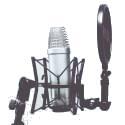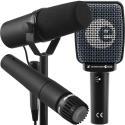When to Use a Shotgun Mic and What Makes It Unique?
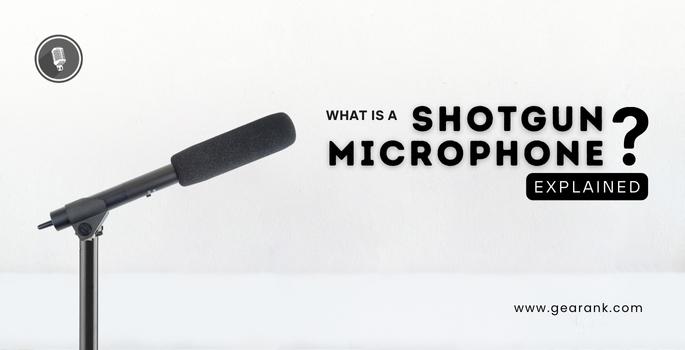
Various recording scenarios need specialized microphones to capture the best sound quality. For live settings, a dynamic mic allows you to move around while performing. Condenser mics for studio recording and ribbon mics for a warmer sound. Need to record for in-field interviews? Get a Lavalier mic.
With all their intended purposes, why should you use a shotgun mic?
Shotgun microphones occupy a niche in film and television, voice-over, and studio recording. The way you use it, however, requires a degree of technical knowledge.
This article is for boom operators, voice-over talents, and musicians. Can a shotgun mic supplement your audio recording or provide improved sound quality? Read along. I'll take a deep dive into shotgun microphones, exploring their features their applications.
What Is A Shotgun Microphone?
A shotgun mic is a long, cylindrical microphone with a highly focused pickup pattern. Its narrow, tube-like form factor is designed with interference slots. This contributes a lot to determining the directionality of this mic. The design allows the microphone to capture sound directly in front of it. At the same time, it attenuates the sounds coming from the sides and rear.
Shotgun mics have a supercardioid or hypercardioid polar pattern. Both patterns are more focused and narrower than the pickup patterns found in most mics.
You've probably seen them often used in film and television productions. They are mounted on boom poles or attached to the top of professional cameras.
They are often placed off-camera to capture dialogue from actors on film sets. They are used in podcast or interviews as well. Shotgun microphones are also vital in broadcast journalism. This allows reporters to capture clear audio in outdoor environments.
How Far Can Shotgun Microphones Reach?
The reach of a shotgun microphone depends on a few different factors. These include the microphone's design, sensitivity, recording environment, and sound sources.
A good thing to know when considering this is the size of the interference tubes on the microphone. Longer interference tubes result in a more focused pickup pattern. This extends the range of the microphone. We will discuss this further in the later parts of this article.
You'll often find that external factors can also impact the distance covered. The microphone placement and the use of windshields can also affect the mics's reach.
Polar Patterns: Lobar, Supercardioid, and Hypercardioid
For the sake of brevity, we'll give you a brief overview here of how polar patterns work in a shotgun microphone. If you want a more detailed breakdown, we urge you to get read up on how polar patterns work.
Shotgun microphones are distinguished by their high sensitivity and focused pickup patterns. As mentioned, it's sensitive from the front while attenuating side and rear signals.
Let's explore these polar patterns in more detail:
Lobar Polar Pattern
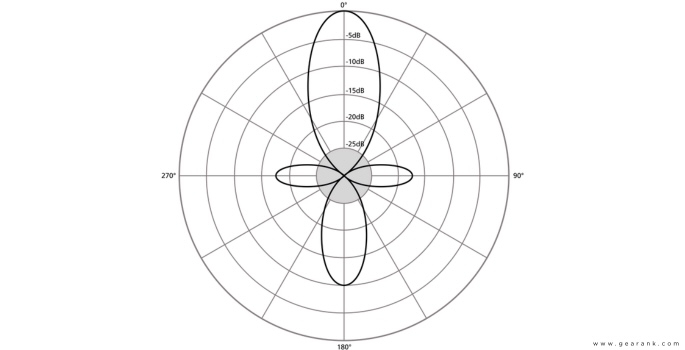
Compared to other types of mics, the lobar polar pattern is the only specialized pickup pattern for shotgun mics. I could best describe it as the elongated variant of supercardioid and hypercardioid. It has a much more extended reach than super cardioid and hypercardioid. The majority of shotgun microphones have front and rear lobes. However, only a small amount of shotgun mics will have "true" lobar 270° and 90° left and right lobes.
The main reason? Most shotgun mics are built around supercardioid or hypercardioid mic capsules. With the interference tube attached on top, the shape of the lobes gets elongated.
This polar pattern type is also called either lobar/supercardioid, or lobar/hypercardioid.
Supercardioid Polar Pattern

The supercardioid polar pattern is an extended version of the classic cardioid pattern. This polar pattern is the industry standard when it comes to dynamic mics and is found in most shotgun mics.
The pickup pattern is shaped like a heart, with a front lobe and smaller rear and side lobes. It has a wider pickup angle compared to the hypercardioid pattern. Microphone placement for supercadioids are more forgiving in terms of directionality. Off-axis, the supercardioid will attenuate sounds such as ambient noise or instruments playing from the sides and back.
Hypercardioid Polar Pattern
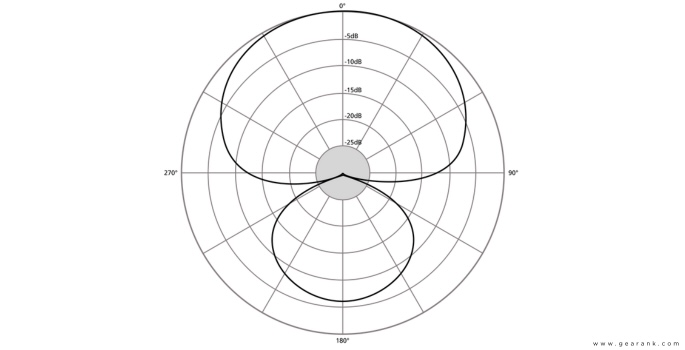
The hypercardioid polar pattern is the extended version of the supercardioid. Shotgun mics of this kind have a tighter front pickup angle but a slightly larger back lobe. Its more focused and narrower front lobe makes hypercardioid highly directional.
Mic placements and angles will affect the sound drastically. Yes, even when it's slightly off-axis. It is incredibly useful in really loud environments that can wash out the sound source. Shotgun mics of this kind are known to reject background noise quite well.
Selecting a Good Professional Shotgun Microphone
Several factors must be considered when selecting a shotgun microphone. Whether you're using it for film or recording music, the sound quality will be affected by the following:
Size and length
Shotgun microphones are available in a variety of lengths, ranging from a few inches to several feet. As the length increases, the interference tubes get a narrower pickup pattern and increased directionality.
Long shotgun mics provide increased noise rejection and can cover longer-distance sound recordings. Operating longer shotguns can be a difficult task. With its highly sensitive directional pattern, it requires you to know how to operate a boom pole.
Medium shotgun mics can be used to cover dialogues at a distance too. You can mount them for close-up dialogues and voice recording applications. They're the convenient in-between of long and short shotgun microphones.
A short shotgun mic covers a wider angle but loses some directionality. This compact shotgun microphone best is used for close-up film dialogues, podcasts, and voice recordings. It doesn't require a high level of skill to operate. Compared to a longer shotgun, however, they're not ideal for isolating sound at a distance.
Off-Axis Coloration
Sound rejection (including rear and side rejection) and attenuation also determine how well the sound gets captured. Off-axis coloration is the change in frequency response when sound is captured from different angles. This applies to the side and the rear of the shotgun mic.
Technically speaking, all shotgun microphones will color the sound off-axis. Good shotgun mics will have less coloration and low self-noise even off-axis.
Popular mic brands like Sennheiser, Shure, Rode, and more offer good quality shotgun mics in different price ranges.
Mounting Options and Accessories
It's worth considering shock mounts that minimize sounds from the movement of the mic. This ensures good sound quality and optimal recording. Some shotgun microphones come with shock mounts while others are sold separately. They come with a variety of mounting options to accommodate different recording scenarios.
You have regular shock mounts that have elastic bands in them to prevent movement. This is typically used for in-filed recordings and even for studios.
Another option would be the camera-mounted shotgun mic. As the name suggests, it's the go-to solution option to attach a boom microphone on top of a camera. Some can be attached to your mobile devices.
For reducing wind noise and protecting the mic from elements, a shotgun microphone windscreen is an indispensable accessory.
A blimp or a dead cat windshield is common in boom operations. The difference between the two is their efficacy in minimizing wind noise. For areas that don't have a lot of wind, a blimp windshield would be enough to protect your mic from the elements. Dead cat windshields are better for ensuring great sound in windy environments.
Shotgun Microphones For Musicians
Shotgun mics are often overshadowed by dynamic and condenser microphones. But when used correctly, shotgun mics offer advantages for specific situations.
Shotgun mics are also a common choice for musicians who want to isolate a single instrument. If there's one rule of thumb for a shotgun microphone…
"Use a shotgun mic in music when you want to favor the sound source while still being able to capture other instruments."
Musicians can opt for a shotgun microphone for capturing specific sounds or instruments. They can be strategically placed to capture the sound of a particular instrument. At the same, time it can minimize bleeding from other sources. They're a great alternative for drum overheads. The purpose is to capture cymbals without the added noise from the ambiance and the crowd.
Shotgun microphones are a niche choice for recording focused pickup patterns. For instance, a scenario where multiple instruments or vocalists are in close proximity. The rear and the sides can still capture the sound. This off-axis coloration can help create a sense of distance and space.
Final Thoughts
Shotgun mics are certainly an intriguing tool that has its own polar pattern. Highly sensitive and directional, shotgun microphones will work on most recording applications.
Not all shotgun mics will capture sound the same way. The longer the mic, the more directional it becomes, and the more low cut occurs. Conversely, shorter shotgun mics will receive sounds and wider angles.
It is heavily utilized for film, outdoor recordings, and interviews - solving the problem of lack of directionality. A shotgun mic can also be a great alternative for recording instruments and vocals as well in specific situations.
That's everything you need to know about what a shotgun microphone is.
Frequently Asked Questions
Can Shotgun Microphones Be Used Outdoors?
Absolutely. Shotgun microphones are a common audio setup in films, documentaries, and in-field interviews. A shotgun microphone features a highly directional pickup pattern. Simply put, it isolates the sound source from sounds like wind, rain, or general street noise.
This makes them ideal for capturing clear audio in outdoor environments. Sound quality can also improve further with additional accessories. I recommend getting a shotgun mic windshield to protect it from outside elements.
What Is A Diaphragm In A Shotgun Mic?
The diaphragm is the component responsible for turning physical sound into electrical signals. The diaphragm vibrates in response to sound waves. The back-and-forth movements are then converted into electrical currents.
Where Is The Best Place To Aim A Shotgun Microphone?
The short answer: the best place to aim the mic is in front of the sound source, around 4-10 feet. This is regardless of whether the sound source is static or moving. Shotgun mics, though, require a degree of active listening and skill. When recording with a boom pole, it's even more crucial. With moving subjects, you have to take note of the angles that will cause the signal to change.
Do You Need Phantom Power for a Shotgun Microphone?
Shotgun microphones need an external power source to work. This can include the power that comes with your camera or phantom power from an audio interface or mixer. Ensure compatibility with your PA system and power setup for smooth operation.
Contributors:
- Allen Articulo - Co-writer
- Jerry Borillo - Illustrator






